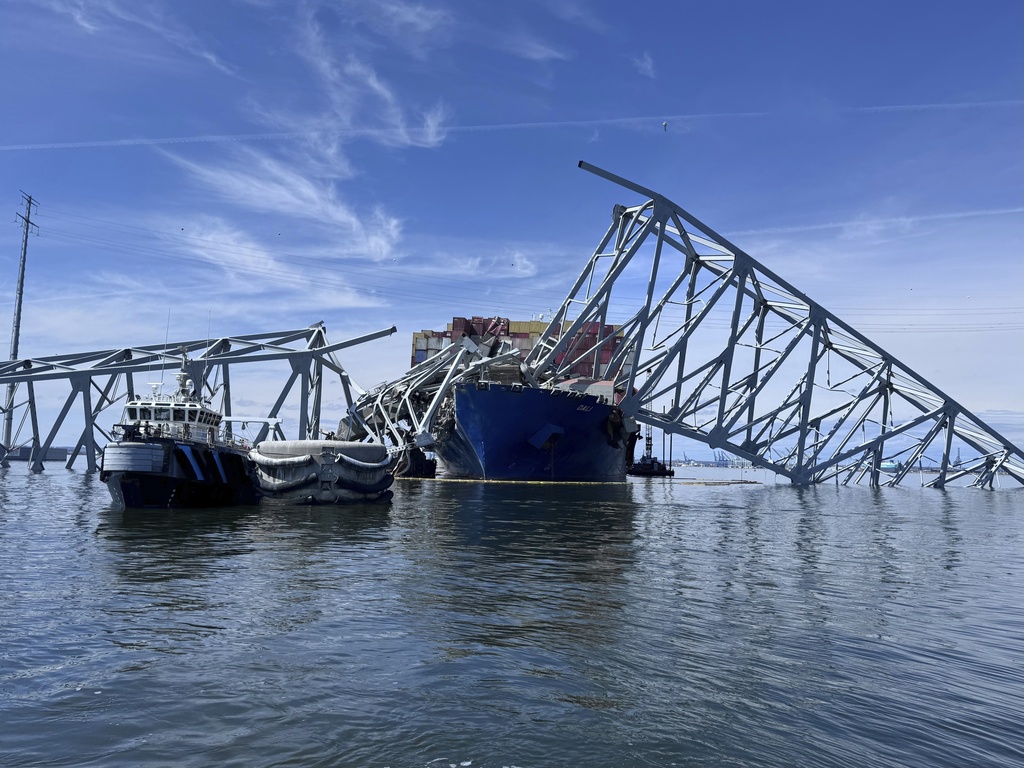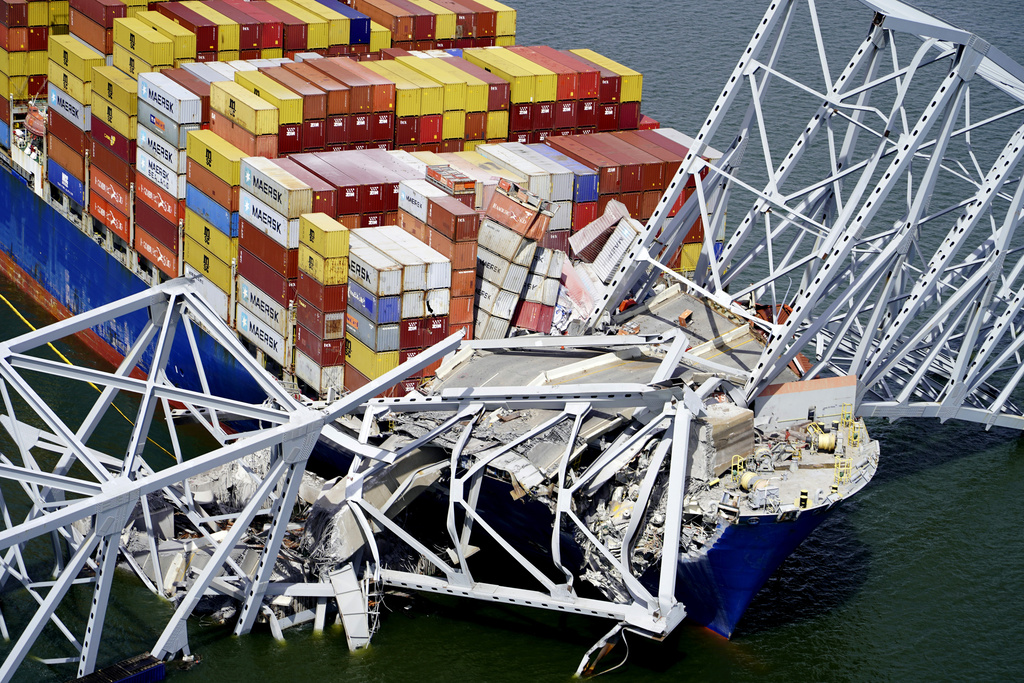Baltimore Bridge Collapse Blamed on Reckless Ship Maintenance \ Newslooks \ Washington DC \ Mary Sidiqi \ Evening Edition \ The Justice Department has filed a lawsuit accusing the owner and manager of the cargo ship that caused the deadly Baltimore bridge collapse of reckless cost-cutting and ignoring known electrical issues. The collapse killed six workers and disrupted port operations for months. The lawsuit seeks over $100 million in damages to cover the government’s cleanup efforts.

Baltimore Bridge Collapse Lawsuit: Quick Looks
- DOJ lawsuit: Filed against ship owner Grace Ocean Private Ltd. and Synergy Marine Group, accusing them of negligence.
- Bridge collapse details: A power outage on the Dali cargo ship led to a fatal crash into the Francis Scott Key Bridge, killing six construction workers.
- Negligence claims: The lawsuit alleges electrical issues were “jury-rigged” rather than properly addressed, contributing to the disaster.
- Ship malfunction: Power and steering failures occurred due to improper maintenance and disabled safety features, according to the DOJ.
- Ongoing legal battles: Victims’ families and the workers’ employer, Brawner Builders, are also filing claims for damages.
Deep Look
The Justice Department has filed a major lawsuit against the owner and manager of the cargo ship Dali, which caused the deadly collapse of the Francis Scott Key Bridge in Baltimore earlier this year. The lawsuit alleges that Grace Ocean Private Ltd. and Synergy Marine Group, both based in Singapore, acted recklessly by ignoring known mechanical and electrical issues, ultimately leading to the tragic incident. The government is seeking over $100 million in damages to cover the extensive costs of clearing debris from the collapse and reopening the Port of Baltimore.
Series of Failures Leading to Disaster
According to the lawsuit filed in Maryland, the Dali experienced a power outage just moments before it struck the bridge’s support column in March, killing six construction workers who were performing an overnight road crew shift. The Justice Department lawsuit provides the most detailed account yet of the ship’s cascading failures, painting a grim picture of cost-cutting, negligence, and dangerous shortcuts. The complaint alleges that both the mechanical and electrical systems on the ship had been “jury-rigged” and improperly maintained, which directly contributed to the power loss.
The Justice Department described the vessel as “unseaworthy” and claimed the companies sent an ill-prepared crew on a vessel riddled with known electrical issues. “This tragedy was entirely avoidable,” the lawsuit stated, blaming the companies for choosing profit over safety and infrastructure.
Power Failures and Crew Helplessness
The ship was leaving Baltimore bound for Sri Lanka when its steering failed due to a power outage as it approached the bridge. The crew was unable to restore power in time, resulting in the devastating crash that brought down a section of the Francis Scott Key Bridge, plunging the workers into the water below.
Documents released by the National Transportation Safety Board (NTSB) indicate that a loose cable on the Dali played a critical role in triggering the blackout. Investigators discovered the cable issue after an initial power outage occurred while the ship was still docked. Crew members had switched from one transformer system to another, unknowingly setting the stage for the catastrophic failure that occurred upon departure.
The Justice Department complaint further reveals that excessive vibrations on the ship were a “well-known cause” of electrical and transformer failures. Rather than properly addressing the root causes, the crew allegedly implemented temporary fixes, referred to as “jury-rigging” in the complaint, which ultimately led to the disaster.
Disabled Safety Features and Slow Response
As the ship lost power and drifted toward the bridge, a safety feature that should have automatically transferred power to a backup system had been disabled. According to the lawsuit, this automation would have allowed the crew to avoid a total power loss, but with the feature disabled, it took the ship’s engineers a full minute to manually restore power — too long to prevent the crash.
The brief restoration of power was not enough, however, as the system failed again due to separate issues with the ship’s fuel pumps, which the DOJ alleges were the result of cost-cutting measures. In the crucial moments before the crash, the ship’s anchor could not be deployed, and the bow thruster was unavailable, leaving the crew with no control over the ship’s trajectory.
Legal Consequences and Ongoing Investigations
The lawsuit not only seeks to recover the $100 million spent clearing debris and reopening the port but also holds Grace Ocean and Synergy Marine Group accountable for the unsafe conditions that led to the deaths of six workers. The Justice Department is also fighting the companies’ attempts to limit their legal liability, a tactic commonly used in marine casualty cases to reduce financial responsibility.
“We are working to ensure that the costs of clearing the channel and reopening the Port of Baltimore are borne by the companies that caused the crash, not by the American taxpayer,” said Attorney General Merrick Garland in a statement. The companies have denied any wrongdoing and are preparing to defend themselves in court. Darrell Wilson, a spokesperson for Grace Ocean, stated that the company looks forward to “setting the record straight” in court but offered no further comment on the specifics of the claim.
The FBI boarded the Dali in April, but Justice Department officials have declined to comment on whether a criminal investigation into the collapse is still ongoing.
Victims’ Families and Other Claims
In addition to the federal government’s claim, the families of the victims have announced their own plans to file lawsuits against the ship’s owners and managers. The construction company Brawner Builders, which employed the victims, has also filed a separate claim seeking damages for the loss of “six beloved employees”, as well as the loss of vehicles and construction equipment.
According to documents from the NTSB, the ship’s electrical systems were in such poor condition that an independent agency halted further testing due to safety concerns. Inspectors found cracked equipment, loose nuts and bolts, and broken electrical ties in the engine room. The Justice Department argues that these glaring issues should have prevented the ship from ever setting sail.
In his remarks, Chetan A. Patil, Acting Deputy Assistant Attorney General, emphasized the gross negligence involved: “In sum, this accident happened because of the careless and grossly negligent decisions made by Grace Ocean and Synergy.”
He added that the companies “recklessly chose to send an unseaworthy vessel” into a critical waterway, ignoring the obvious risks that ultimately led to a catastrophic loss of life and the prolonged closure of a vital shipping route.
Baltimore-bridge-collapse Baltimore-Bridge-Collapse Baltimore-Bridge-Collapse







